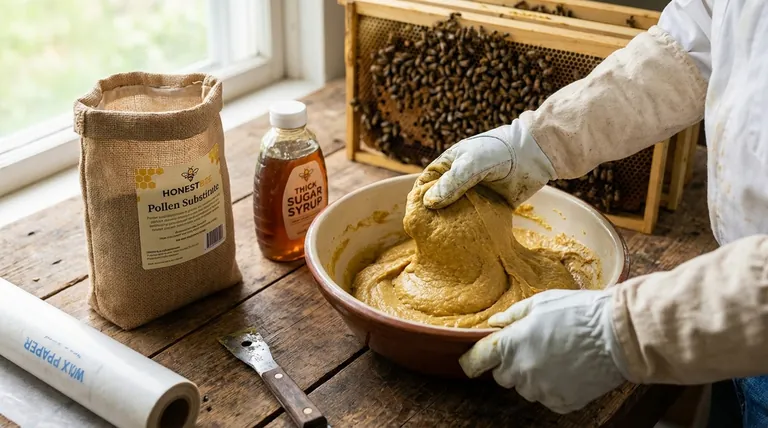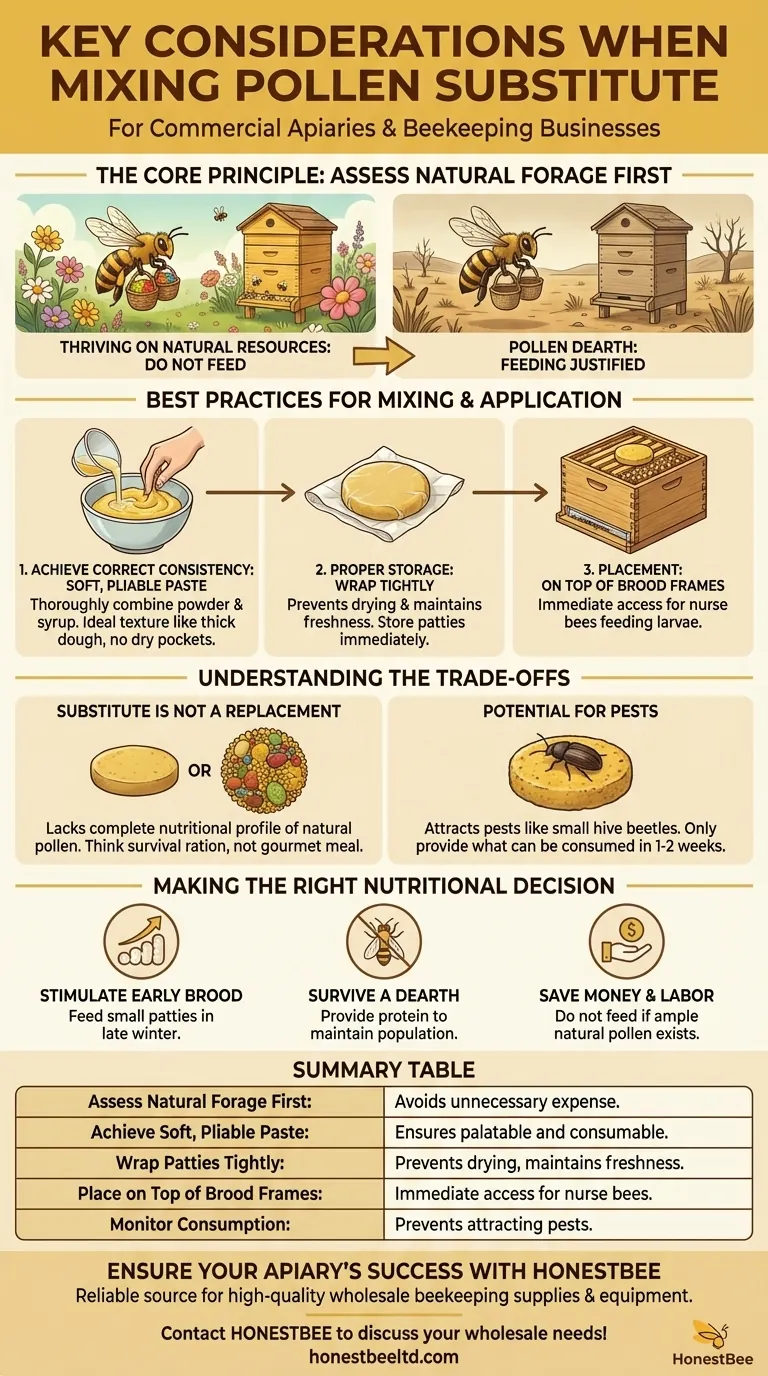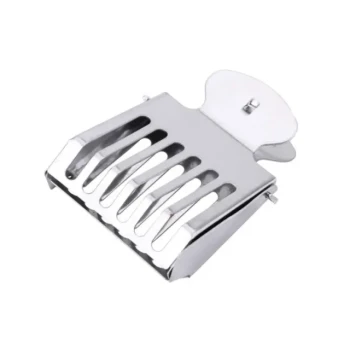The primary considerations when mixing pollen substitute are achieving the correct consistency and ensuring the final product remains fresh. You must thoroughly combine the powder with sugar syrup to form a soft, pliable paste, then wrap it tightly to prevent it from drying out and becoming unusable for your bees.
The most common mistake isn't in the mixing, but in the timing. Before you even open a bag of substitute, the most important step is to assess whether your bees have access to adequate natural pollen, as feeding them when it's not needed is an unnecessary expense and effort.

The Core Principle: Why and When to Feed
The goal of supplemental feeding is to support a colony, not to replace natural forage. Understanding when to intervene is more critical than the mixing technique itself.
Assessing Natural Forage First
Before providing a substitute, inspect your hive and your local environment. Look for bees returning to the hive with full pollen baskets of varied colors.
If you see ample, diverse pollen coming in and frames of stored "bee bread," your colony is thriving on natural resources. In this situation, adding a substitute is a waste of money and resources.
Identifying a True Pollen Dearth
Supplemental feeding is justified during a pollen dearth—a period when natural pollen is scarce.
This often occurs in late winter or very early spring before flowers bloom, or during a summer drought. During these times, the queen may reduce her laying rate due to the lack of protein, and a substitute can provide the nutrition needed to build up the colony's population.
Best Practices for Mixing and Application
Once you have determined a substitute is necessary, proper preparation ensures the bees can actually use it.
Achieving the Correct Consistency
The ideal texture is a soft, pliable paste, similar to thick dough or peanut butter.
If the mixture is too dry, bees will struggle to consume it. If it's too wet and runny, it can be messy and less appealing. Always mix the powder and syrup thoroughly until no dry pockets remain.
The Importance of Proper Storage
Pollen substitute dries out very quickly when exposed to air. Once mixed, it should be immediately formed into patties and wrapped tightly in wax paper or plastic wrap.
This preserves moisture, keeps the patty soft and palatable for the bees, and allows you to store patties for later use.
Placement Within the Hive
For maximum effectiveness, place the pollen patty directly on top of the brood frames, as close to the cluster of bees as possible. This ensures the nurse bees responsible for feeding the larvae have immediate access to the protein.
Understanding the Trade-offs
While beneficial in the right circumstances, pollen substitutes are not a perfect solution and come with clear limitations.
Substitute is Not a Replacement
Even the best pollen substitute lacks the complete nutritional profile of diverse, natural pollen. Natural sources contain unique micronutrients, fats, and sterols essential for long-term colony health. Think of a substitute as a survival ration, not a gourmet meal.
Potential for Pests
Pollen patties can attract hive pests, especially small hive beetles. Only provide a patty size that the colony can consume in a reasonable amount of time (e.g., one to two weeks). If the bees are not actively consuming it, remove it to prevent it from becoming a pest breeding ground.
Making the Right Nutritional Decision for Your Colony
Your approach to feeding should be dictated by a clear goal, based on observation of the hive and its environment.
- If your primary focus is stimulating early brood rearing: Feed small patties in late winter to provide the protein needed for the queen to begin laying ahead of the first natural pollen flow.
- If your primary focus is surviving a dearth: Provide a substitute to ensure the colony has the protein necessary to maintain its population and prevent a decline in brood production.
- If your primary focus is saving money and labor: Do not feed if you observe bees actively bringing in ample natural pollen, as the substitute will likely be ignored and your resources wasted.
Ultimately, successful bee nutrition is about making informed decisions based on what the colony truly needs.
Summary Table:
| Key Consideration | Why It Matters |
|---|---|
| Assess Natural Forage First | Avoids unnecessary expense and effort if bees have adequate pollen. |
| Achieve Soft, Pliable Paste | Ensures the substitute is palatable and consumable for the bees. |
| Wrap Patties Tightly | Prevents drying, maintains freshness, and allows for storage. |
| Place on Top of Brood Frames | Provides immediate access for nurse bees feeding larvae. |
| Monitor Consumption | Prevents patties from attracting pests like small hive beetles. |
Ensure your apiary's nutritional success with HONESTBEE.
Mixing and managing pollen substitutes is just one part of effective hive management. For commercial apiaries and beekeeping equipment distributors, having a reliable source for high-quality supplies is crucial for operational efficiency and colony health.
HONESTBEE supplies beekeeping supplies and equipment through wholesale-focused operations, helping you maintain strong, productive colonies. Let us support your business with the tools you need to succeed.
Contact HONESTBEE today to discuss your wholesale needs and keep your operations buzzing!
Visual Guide

Related Products
- HONESTBEE Professional Entrance Bee Feeder Hive Nutrition Solution
- Economy Galvanized Beekeeping Honey Bee Smoker for Wholesale
- Professional Bee Smoker with Elongated Spout and Durable Bellows for Beekeeping
- Professional Galvanized Hive Strap with Secure Locking Buckle for Beekeeping
- High Performance Cordless Electric Bee Shaker for Beekeeping
People Also Ask
- Are entrance feeders good for bees? Prioritize Hive Health Over Convenience
- What precautions should be taken when feeding bees inside the hive? Safeguard Your Colony from Robbing and Leaks
- How does the entrance feeder method work? A Guide to Simple But Risky Hive Feeding
- How does a bee entrance feeder work? A Simple Guide to Convenient Hive Feeding
- What are the different types of honey bee feeders? Choose the Right Feeder for Your Hive



















